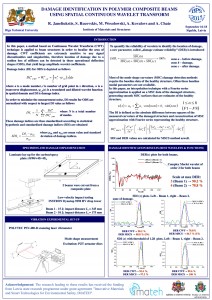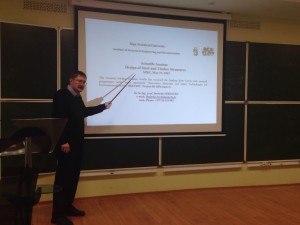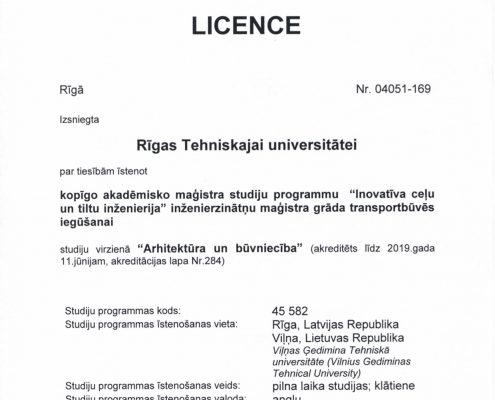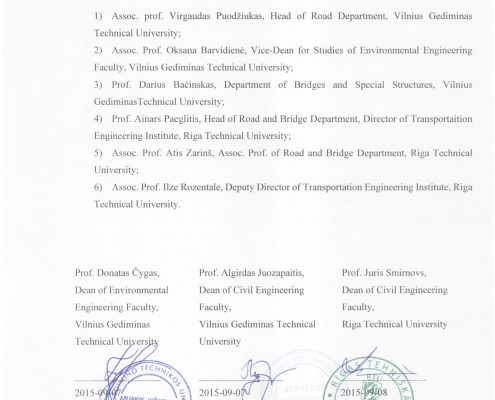The demand for use of methods of construction risk and reliability analysis in economy has considerably increased in last decades. The methods of structural risk and reliability analysis is a cross-disciplinary engineering science area that requires the use of different parts of construction science, as well as understanding of probability, reliability and decision-making methods.
Undesirable large-amplitude vibrations and radiated noise are not only impeding the effective operation of various types of dynamic civilian and military system, but also have a negative effect on a human environment. Noise and vibration are among the most significant issues for European community citizens. The growth in public awareness and expectations of environmental performance has led industries to focus their attention on the potential impacts arising from noise and vibration of structures and how to control and reduce them. Regarding this it is important to note the Directive 2002/49/EC of the European Parliament and of the Council relating to the assessment and management of environmental noise.
It is well known that the association of a thin polymer layer between two metallic or composite layers permits to manufacture sheet metals having a strong absorbing energy without losing stiffness and resistance properties. These sandwich sheet metals are good noise and vibration reducers. Since the discovery of the reverse effect (actuator aspect) of the piezoelectric materials, it was proved that the latter can be used either passively through electronic shunts, or actively, through a set of electronic devices (amplifiers, controllers, etc.), for structural vibration damping.
The latest developments and methodologies for structural health monitoring and damage identification might be categorized into two general types of methods: local experimental methods: acoustic or ultrasonic methods, magnetic field methods, radiography, eddy-current methods or thermal field methods; and global methods such as vibration-based damage detection methods.
Challenge of the project is to adapt the developed vibration-based damage identification tool to the use of embedded sensors within structures. In this case dynamic characteristics of a structure are obtained by means of embedded sensors from ambient vibrations of a structure during its service or from forced vibrations by means of embedded sensor/actuator. Further the developed vibration-based damage identification tool and embedded sensor technology will be used for the development of on-line structural health monitoring methods. Effective solutions for on-line structural health monitoring and damage detection can increase safety, extend serviceability, reduce maintenance costs and define reducing operating limits for structures.
The investigation of the dynamic properties is an important reliability issue that considerable affects the performance and life-time of bridge structures. The development of transport systems and transport logistic require the efficient use of surface transport and infrastructure – roads and bridges. To achieve the high degree efficiency of transportation even larger and heavy vehicles will be used. In many cases, the bridges are subjected to loads exceeding the loads specified in standards that increase the development of damages and increase the probability of structural collapse.
The society expects that the collapse of the bridges will never happen or happen very rarely, it also relies on the professional knowledge and skills of the engineers involved in bridge design and maintenance.
The project provides the examination of the vehicle and roadway interaction and to develop a mathematical model to study the dynamic behavior of the bridge, develop the method for assessment of new bridge dynamic characteristics, investigation of the vehicle weight and speed impact on the structural dynamic characteristics of bridges, development of method for assessment of existing bridge dynamic characteristic, as well development of the recommended limits of the bridge dynamic characteristics.
The development of the modern technologies and more accurate methods of structural analysis raises the risks of loses of its load carrying capacity reserves due to insufficient strength caused by errors of the human activities or natural disasters. The assessment of risks is the part of the risk management that ensures the risk analysis and evaluation of its consequences. Risk assessment for decision-makers and the responsible parties provide a better understanding of possible risks, as well as an appropriate and effective control. Usually for the evaluation of the structural safety are used the general Eurocode approach, which is proposed for all kinds of new structures.
Therefore, it is important to develop a method for the determination of the bridge safety, taking into account the potential risk scenarios, characteristic for Latvia’s traffic load, the bridge material characteristics and models of the damage development for structural elements.
Project provide approbation of theoretical probability distribution models of bridge loads in Latvia, development of method for prediction of external action combinations, development of mathematical model describing influence of building materials physical uncertainty on loadbearing capacity, development of mathematical model describing influence of geometrical uncertainty on loadbearing capacity, as well estimation of safety index defined in Eurocodes for existing bridges.
The method developed for establishing of the size and location of the area of damage by using experimentally obtained dynamic parameters, and the corresponding signal processing methods will allow to assess the safety of the bridges, buildings and technological equipment.

Project manager
 |
Ainārs Paeglītis, Dr.sc.ing. Rīgas Tehniskā universitāte |
Executors
 |
Andris Čate, Dr.sc.ing. Rīgas Tehniskā universitāte Materiālu un konstrukciju institūts |
 |
Diāna Bajāre, Dr.sc.ing. Rīgas Tehniskā universitāte Materiālu un konstrukciju institūts |
 |
Sandris Ručevskis, Dr.sc.ing. Rīgas Tehniskā universitāte Materiālu un konstrukciju institūts |
 |
Ilze Paeglīte, M.sc.ing. Rīgas Tehniskā universitāte |
 |
Andrejs Kovaļovs, Dr.sc.ing. Rīgas Tehniskā universitāte Materiālu un konstrukciju institūts |
 |
Rims Janeliukštis, M.sc.ing. Rīgas Tehniskā universitāte Materiālu un konstrukciju institūts |
 |
Andris Freimanis, M.sc.ing. Rīgas Tehniskā universitāte |
 |
Dmitrijs Serdjuks, Dr.sc.ing. Rīgas Tehniskā universitāte |
 |
Aivars Vilguts, M.sc.ing. Rīgas Tehniskā universitāte |
 |
Verners Straupe, Dr.sc.ing. Rīgas Tehniskā universitāte |
 |
Vadims Goremikins, Dr.sc.ing. Rīgas Tehniskā universitāte |
| Publication Title | Authors | Proceedings , Journal | Status |
| Design Methods of Elements from Cross-Laminated Timber Subjected to Flexure | A. Vilguts, D. Serdjuks, L. Pakrastins | Procedia Engineering, Elsevier, Volume 117, 2015, 10.–19., ISSN 1877-7058 |
Published Link Presentation |
| Dynamic amplification factors of some city bridges | I. Paeglite, A. Paeglitis | International Journal of Civil, Architectural, Structural and Construction Engineering, World Academy of Science, Engineering and Technology, 2014, Vol.8, No.12, ISSN 1307-6892 |
Published Download Presentation |
| Materials Consumption Decrease for Long-span Prestressed Cable Roof | A. Stuklis, D. Serdjuks, V. Goremikins | Environment. Technology. Resources : Proceedings of the 10th International Scientific and Practical Conference, Rezekne Higher Education Institution, 2015, 209.-215., ISSN 1691-5402 |
Published Link |
| Damage identification in beam structure using mode shape data: from spatial continuous wavelet transform to mode shape curvature methods | R. Janeliukstis, S. Rucevskis, M. Wesolowski, A. Chate, A. Kovalovs | Proceedings of ICoEV 2015: International Conference on Engineering Vibration, University of Ljubljana, 1.-10. | Published |
| Damage Identification in Polymer Composite Beams based on Spatial Continuous Wavelet Transform and Mode Shape Curvature Squares | R. Janeliukstis, S. Rucevskis, M. Wesolowski, A. Chate, A. Kovalovs | Baltic Polymer Symposium 2015: Programme and Proceedings, RTU Press, 105.-105. | Published |
| Damage Identification in Beam Structure using Spatial Continuous Wavelet Transform | R. Janeliukstis, S. Rucevskis, M. Wesolowski, A. Chate, A. Kovalovs | IOP Conference Series: Materials Science and Engineering, IOP Publishing, Vol.96, Iss.1, 2015, 012058. – 012058., ISSN 1757-8981 |
Published Link |
| Design Methods for Load-bearing Elements from Crosslaminated Timber | A. Vilguts, D. Serdjuks, V. Goremikins | IOP Conference Series: Materials Science and Engineering, IOP Publishing, Vol.96, Iss.1, 2015, 1.-10., ISSN 1757-8981 |
Published Link |
| Saiteabstract The Dynamic Amplification Factor for bridges with span length from 10 to 35 meters | I. Paeglite, A. Paeglitis, J. Smirnovs | Engineering Structures and Technologies, Taylor & Francis Group, Vol.6, Iss.3, 2015, 1.-8., ISSN 2029-882X  |
Published Link |
| Modeling of traffic loads for bridge spans from 200 to 600 meters | A. Freimanis, A. Paeglītis | Civil Engineering ’15: 5th International Scientific Conference: Proceedings. Vol.5., Latvia University of Agriculture, 2015, 15.-23., ISSN 2255-7776 | Published Link |
| Damping Properties of Sandwich Truss Core Structures by Strain Energy Method | R. Janeliukstis, S. Rucevskis, M. Wesolowski, M. Polanski | IOP Conference Series: Materials Science and Engineering, IOP Publishing, Vol.96, Iss.1, 2015, 012022.-012022., ISSN 1757-8981 |
Published Link |
| Effectiveness of Application of Modal Analysis for the Monitoring of Stressed or Operated Structures | A. Mironov, P. Doronkin, A. Priklonsky, A. Chate | Aviation, Vol.19, No.3, 2015, 112.-122., ISSN 1648-7788 |
Published Link |
| Dynamic effects caused by the vehicle-bridge interaction | I. Paeglite, J. Smirnovs | Civil Engineering ’15 : 5th International Scientific Conference : Proceedings. Vol.5, 2015, 11.-14., ISSN 2255-7776 | Published Link |
| Behaviour Analysis of Load-Bearing Aluminum Members | A. Hirkovskis, D. Serdjuks, V. Goremikins, L. Pakrastins, N.I. Vatin | Magazine of Civil Engineering, Peter the Great St.-Petersburg Polytechnic University, 2015, No.5, 86.-96., ISSN 2071-4726 | Published Link |
| Vibration-Based Approach for Structural Damage Detection | S. Rucevskis, R. Janeliukstis, P. Akishin, A. Chate | Proceedings of the 23rd International Congress on Sound and Vibration, International Institute of Acoustics and Vibration (IIAV), 2016, 1.-8., ISSN 2329-3675 |
Published Download |
| Multiple damage identification in beam structure based on wavelet transform | R. Janeliukstis, S. Rucevskis, M. Wesolowski, A. Chate | — | Published |
| Damage Identification Dependence on Number of Vibration Modes Using Mode Shape Curvature Squares | R. Janeliukstis, S. Rucevskis, M. Wesolowski, A. Chate | Journal of Physics: Conference Series, IOP Publishing, Vol.744, No.1, 2016, 1.-12., ISSN 1742-6588 |
Published Download |
| Wavelet transform based damage detection in a plate structure | R. Janeliukstis, S. Rucevskis, P. Akishin, A. Chate | Procedia Engineering, Elsiever, 2016, Vol.161, 127.-132. ISSN 1877-7058 |
Published Download |
| Comparision of constant-span and influence line methods for long-span bridge load calculations | A. Paeglītis, A. Freimanis | The Baltic Journal of Road and Bridge Engineering, (2016), Vol.11, No.1, pp.84–91. ISSN 1822-427X. |
Published Download |
| Mode shape-based damage detection in plate structure without baseline data |
S. Rucevskis, R. Janeliukstis, P. Akishin, A. Chate | Structural Control and Health Monitoring, John Wiley & Sons, Ltd., 2016, Vol.23, Iss.9, pp.1180.-1193., ISSN 1545-2255 |
Published Download |
| Damage Identification in Polymer Composite Beams Based on Spatial Continuous Wavelet Transform | R. Janeliukstis, S. Rucevskis, A. Kovalovs, M. Wesolowski, A. Chate | IOP Conference Series: Materials Science and Engineering, IOP Publishing, 2016, Vol.111, Iss.1, 1.- 6., ISSN 1757-8981 |
Published Download |
| Experimental verification of design procedure for elements from cross-laminated timber |
K. Buka-Vaivade, D. Serdjuks, V. Goremikins, A. Vilguts, L. Pakrastins |
Procedia Engineering, Elsevier, In Press, 2016, 1.-9. ISSN 1877-7058 |
Published Download |
| Behaviour of load-carrying members of velodromes’ long-span steel roof |
J. Gusevs, D. Serdjuks, G.I. Artebjakina, E.A. Afanasjeva, V. Goremikins | Magazine of Civil Engineering, SPbU, No.5, 2016, 3.-16. ISSN 2071-4726 | Published Download |
| Fire design of arch-type timber roof | T. Saknite, D. Serdjuks, V. Goremikins, L. Pakrastins, N.I. Vatin | Magazine of Civil Engineering, SPbU, No.4, 2016, 26.-39. ISSN 2071-4726 |
Published Download |
| Peridynamic mesh sensitivity analysis for quasi-static simulations | A. Freimanis*, A. Paeglitis | Procedia Engineering, Elsevier, 2016 |
Published Download |
| Dynamic behavior of pre-stressed slab bridges | I. Paeglite*, J. Smirnovs, A. Paeglitis | Procedia Engineering, Elsevier, 2016, 1.-8. ISSN 1877-7058 |
Published Download |
| Traffic load effects on dynamic bridge performance | I. Paeglite, J. Smirnovs, A. Paeglitis | Maintenance, Monitoring, Safety, Risk and Resilience of Bridges and Bridge Networks @ Taylor & Francis Group, 2016, 2364. – 2369. ISBN 978-1-138-02851-7 |
Published Download |
| Comparision of Constant-Span and Influence Line Methods for Long-Span Bridge Load Calculations | A. Paeglitis, A. Freimanis | Baltic Journal of Road and Bridge Engineering, Vol.11, No.1, 2016, 84. – 91. ISSN 1822-427X |
Published Download |
| Numerical Investigation on Multiclass Probabilistic Classification of Damage Location in a Plate Structure | R. Janeliukstis, S. Rucevskis, A. Kovalovs, A. Chate | International Conference on Structural Engineering Dynamics ICEDyn 2017, Technical Programme & Book of Abstracts, 57. – 58. | Published Download |
| Vibration-based damage identification in railway concrete sleepers | R. Janeliukstis, A. Clark, S. Rucevskis, S. Kaewunruen | SMAR 2017 – Fourth Conference on Smart Monitoring, Assessment and Rehabilitation of Civil Structures, Technical Programme & Book of Abstracts |
Published Download |
National Research programme report for 2014 year
Participation in conferences:
 I. Paeglite, A. Paeglitis. Dynamic amplification factors of some city bridges. International Conference on Structural and Construction Engineering (ICSCE) 2014, 22.12-23.12.2014, London, United Kingdom.
I. Paeglite, A. Paeglitis. Dynamic amplification factors of some city bridges. International Conference on Structural and Construction Engineering (ICSCE) 2014, 22.12-23.12.2014, London, United Kingdom.
https://www.waset.org/conference/2014/12/london/ICSCE
National Research programme report for 2015 year
Participation in conferences:
 A. Vilguts, D. Serdjuks, V. Goremiks. Design methods for load-bearing elements from cross-laminated timber. 2nd International Conference “Innovative Materials, Structures and Technologies, September 30- October 2, Riga, Latvia.
A. Vilguts, D. Serdjuks, V. Goremiks. Design methods for load-bearing elements from cross-laminated timber. 2nd International Conference “Innovative Materials, Structures and Technologies, September 30- October 2, Riga, Latvia.
I. Paeglīte, J. Smirnovs. Traffic load effect on bridge dynamic response. 2nd International Conference “Innovative Materials, Structures and Technologies, September 30- October 2, Riga, Latvia.
A. Freimanis, A. Paeglītis. Analysis of yearly traffic fluctuation on Latvian highways. 2nd International Conference “Innovative Materials, Structures and Technologies, September 30- October 2, Riga, Latvia.
R. Janeliukstis, S. Rucevskis, M. Wesolowski, A. Kovalovs, A. Chate. Damage identification in beam structure using spatial continuous wavelet transform. 2nd International Conference “Innovative Materials, Structures and Technologies, September 30- October 2, Riga, Latvia.
Baltic Polymer Symposium 2015 (pdf.)

Performance indicators:
05.21.15. It was organized and led scientific seminar “Design of steel and timber structures” (SPbU), which took place in St. Petersburg State Polytechnic University. The seminar was chaired by prof. Dmitry Serdjuks (presentation).

Economic performance indicators:
June 17, 2015 Riga Technical University, and the limited liability company “D and D Center” concluded a cooperation agreement in the project No. 3 “Risk for evaluating the safe, efficient and sustainable buildings”. According to the agreement the parties cooperate in the implementation of projects in accordance with the project objectives: to develop new methods for risk assessment of buildings and structures in order to ensure safe, efficient and sustainable operation.
Cooperation agreement
During the 2016. year has been licensed masters program between Vilnius Gediminas Technical University and Riga Technical University.
Name of the program: “Innovative Road and bridge engineering”
The program provides 1.5 years of training in English language.
Participation in conferences:
 I. Paeglite, J. Smirnovs, A. Paeglitis. “The Dynamic behavior of pre-stressed slab bridges”, 12th International Conference “Modern Building Materials, Structures and Techniques MBMST 2016”, 26-27 May 2016, Vilnius, Lithuania, presentation, MBMST 2016
I. Paeglite, J. Smirnovs, A. Paeglitis. “The Dynamic behavior of pre-stressed slab bridges”, 12th International Conference “Modern Building Materials, Structures and Techniques MBMST 2016”, 26-27 May 2016, Vilnius, Lithuania, presentation, MBMST 2016
R. Janeliukstis, S. Rucevskis, M. Wesolowski, A. Chate. “Multiple damage identification in beam structure based on wavelet transform”, 12th International Conference “Modern Building Materials, Structures and Techniques MBMST 2016”, 26-27 May 2016, Vilnius, Lithuania, presentation, MBMST 2016
K. Buka-Vaivade, D. Serdjuks, V. Goremikins, A. Vilguts, L. Pakrastins. “Experimental verification of design procedure for elements from cross-laminated timber”, 12th International Conference “Modern Building Materials, Structures and Techniques MBMST 2016”, 26-27 May 2016, Vilnius, Lithuania, presentation, MBMST 2016
 R. Janeliukstis, S. Rucevskis, P. Akishin, A. Chate. “Wavelet transform based damage detection in a plate structure”, WMCAUS 2016 – World Multidisciplinary Civil Engineering-Architecture-Urban Planning Symposium, 13-17 June 2016, Prague, Czech Republic, presentation, WMCAUS
R. Janeliukstis, S. Rucevskis, P. Akishin, A. Chate. “Wavelet transform based damage detection in a plate structure”, WMCAUS 2016 – World Multidisciplinary Civil Engineering-Architecture-Urban Planning Symposium, 13-17 June 2016, Prague, Czech Republic, presentation, WMCAUS
 I. Paeglite, A. Paeglitis, J. Smirnovs. “Traffic load effects on dynamic bridge performance”, 8th International Conference on Bridge Maintenance, Safety and Management IABMAS 2016, 26-30 June 2016, Foz do Iguaçu, Brazil, IABMAS 2016
I. Paeglite, A. Paeglitis, J. Smirnovs. “Traffic load effects on dynamic bridge performance”, 8th International Conference on Bridge Maintenance, Safety and Management IABMAS 2016, 26-30 June 2016, Foz do Iguaçu, Brazil, IABMAS 2016
 R. Janeliukstis, S. Rucevskis, M. Wesolowski, A. Chate. “Damage Identification Dependence on Number of Vibration Modes Using Mode Shape Curvature Squares”, MoViC & RASD 2016 – 13th International Conference on Motion and Vibration Control and 12th International Conference on Recent Advances in Structural Dynamics, 3-6 July 2016, Southampton, UK, presentation, MoViC & RASD 2016
R. Janeliukstis, S. Rucevskis, M. Wesolowski, A. Chate. “Damage Identification Dependence on Number of Vibration Modes Using Mode Shape Curvature Squares”, MoViC & RASD 2016 – 13th International Conference on Motion and Vibration Control and 12th International Conference on Recent Advances in Structural Dynamics, 3-6 July 2016, Southampton, UK, presentation, MoViC & RASD 2016
 S. Ručevskis, R. Janeliukštis, P. Akišins, A. Čate. “Vibration-Based Approach for Structural Damage Detection”, The 23rd International Congress on Sound and Vibration, 10-14 July 2016, Athens, Greece, presentation, ICSV23
S. Ručevskis, R. Janeliukštis, P. Akišins, A. Čate. “Vibration-Based Approach for Structural Damage Detection”, The 23rd International Congress on Sound and Vibration, 10-14 July 2016, Athens, Greece, presentation, ICSV23
 A. Freimanis, A. Paeglītis.
A. Freimanis, A. Paeglītis.
“Satiksmes slodžu iedarbju teorētisko varbūtību sadalījumu modeļu aprobācija Latvijas apstākļiem”, Riga Technical University 57th international scientific conference, 14.-18.10.2016, Rīga, Latvija, presentation
R. Janeliukštis. “Konstruktīvo elementu dinamisko parametru eksperimentālās noteikšanas metodoloģijas izstrāde un tās pielietošana konstrukciju tehniskā stāvokļa monitoringam”, Riga Technical University 57th international scientific conference, 14.-18.10.2016, Rīga, Latvija, presentation
I. Paeglīte, J. Smirnovs. “Transportlīdzekļu svara un kustības ātruma ietekmes novērtēšana uz konstrukcijas dinamiskajām īpašībām”, Riga Technical University 57th international scientific conference, 14.-18.10.2016, Rīga, Latvija, presentation
D. Serdjuks, V. Goremikins, K. Buka-Vaivade. “To develop innovative smart structure with using of removable natural resources with the increased durability and reliability for structural and infrastructural purposes”, Riga Technical University 57th international scientific conference, 14.-18.10.2016, Rīga, Latvija, presentation
Participation in seminars:
D. Serdjuks, “Design of Timber Structures by EN 1995-1-1”, SPbU, February 24, 2016, presentation
D. Serdjuks, “Fire Design of Timber Structures by EN 1995-1-2”, SPbU, March 26, 2016, presentation
D. Serdjuks, “Design of Timber Structures by EN 1995-1-1”, RTU, November 17, 2016, presentation
Participation in conferences:

R. Janeliukstis, S. Rucevskis, A. Kovalovs, A. Chate. “Numerical Investigation on Multiclass Probabilistic Classification of Damage Location in a Plate Structure”,
International Conference on Structural Engineering Dynamics ICEDyn 2017, 3 – 5 July, Ericeira, Portugal.
presentation , ICEDyn 2017

R. Janeliukstis, A. Clark, S. Rucevskis, S. Kaewunruen. “Vibration-based damage identification in railway concrete sleepers”, SMAR 2017 – Fourth Conference on Smart Monitoring, 13 – 15 September, Zurich, Switzerland.
presentation , SMAR 2017
Promotion indicators of programme:
2 full text scientific articles have been published, accepted for publication or prepared for publication:
• Buka-Vaivade K., Serdjuks D., Goremikins V., Vilguts A., Pakrastins L. “Experimental Verification of Design Procedure for Elements from Cross-Laminated Timber. Procedia Engineering 172(2017), p. 1212-1219 (cited SCOPUS data basis).
• Goremikins V., Serdjuks D., Buka-Vaivade K., Pakrastins L. „Choice of Rational Structural Solution for Smart Innovative Suspension Structure.” IOP Conference Series, Proceedings of 3rd International Conference Innovative Materials, Structures and Technologies (provides citation for SCOPUS and WoS databases).
For the results obtained, the report is expected at the 1 international conference:
• Goremikins V., Serdjuks D., Buka-Vaivade K., Pakrastins L. „Choice of Rational Structural Solution for Smart Innovative Suspension Structure.” 3 rd International Conference „Innovative materials, Structures and Technologies” 2017, September 27 – 29, Riga, Latvia.
2 master’s theses have been developed and defended in the reference stage on the themes of the project:
• Karīna Buka-Vaivade, “Innovative device for construction with cross-glued timber deck “, supervisor. prof. D.Serdjuks.
• Jana Gerasimova, “Calculation methodology test for curved hybrid components “, supervisor, prof. D.Serdjuks.
Scientific projects captured on the IMATEHa database:
• RTU Scientific project “Interconnection of pre-loaded cable trays and curved glued wood board” Nr. ZP-2016/9. Project Manager – supervisor, researcher V.Goremikin.
New doctoral theses attracted to the project:
• Karīna Buka-Vaivade, Doctoral Thesis “Improvement of Cross-Glued Timber Efficiency in Stretched Structures” Scientific Supervisor – Professor Dr. habil.sc.ing. K. Rocēns, Professor Dr.sc.ing. D.Serdjuks, defense in 2021.





